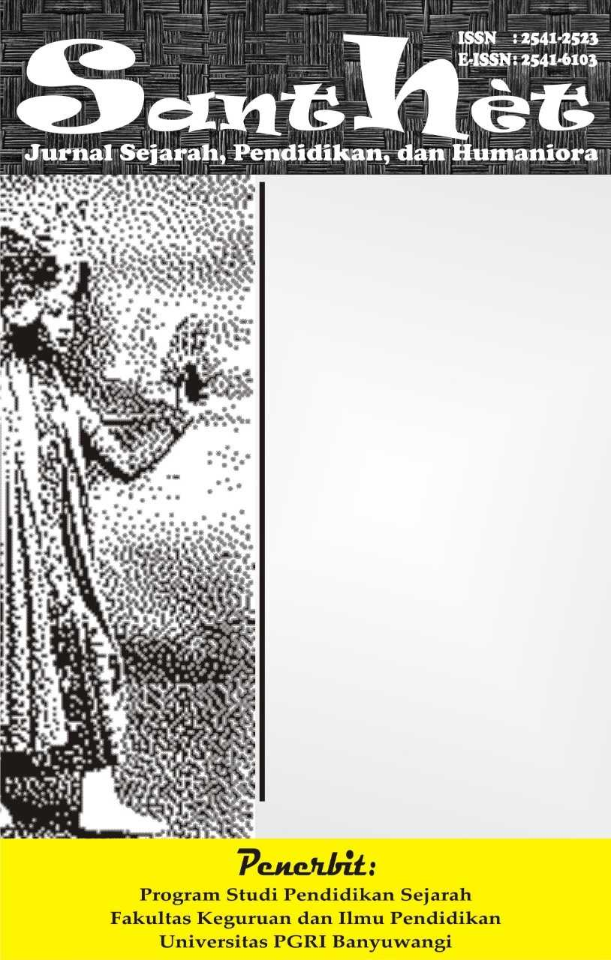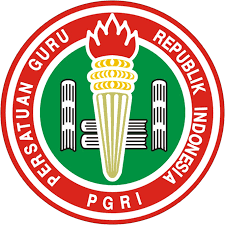Meras Gandrung Tradition as a Cultural Strategy for the Regeneration of Gandrung Dancers in Banyuwangi
Tradisi Meras Gandrung Sebagai Strategi Budaya Untuk Regenerasi Penari Gandrung Di Banyuwangi
DOI:
https://doi.org/10.36526/santhet.v8i1.3678Keywords:
Regeneration, Strategy, Meras GandrungAbstract
Gandrung is one of the works of art that became a means to express the inner state of Banyuwangi people during the Dutch era, Gandrung became an important icon. This is why the regeneration of Gandrung dancers is very important, requiring a strategy to attract the sympathy of the younger generation regarding the Meras Gandrung tradition. The purpose of this research is to be an important contribution to the development of effective cultural strategies, bridging the gap between tradition and the times, and ensuring the continuity of a cultural heritage that is very valuable to the people of Banyuwangi. The form of this research is descriptive qualitative. The theory used is the theory of cultural inheritance by Edward T. Hall. Data collection techniques using interviews, observations, and document studies. The results of the research show that the existing strategy is an important movement so that students or even the general public know that to become a Gandrung must go through the Meras Gandrung Tradition, the infrastructure created by the government is an important forum for Gandrung maestros and fairies to convey the meaning of Gandrung, besides that the Meras Gandrung Performance is an important strategy because it involves young Banyuwangi dancer students to know the process and meaning of Gandrung. This can be studied using the theory of cultural inheritance according to Edward T. Hall, in his theory of cultural inheritance, emphasizes the importance of the cultural level dimension. He understands that the values, norms and communication patterns of a culture can be passed on and maintained through generations. His concept of cultural level dimensions includes differences in such things as perceptions of time, interpersonal space, and ways of communicating, all of which contribute to how culture is passed on and continues in a society.
References
Creswell, J. W. 2007. , Qualitative inquiry and research design: Choosing Among Five Approaches (2nd ed.),. In Sage Publications (pp. 37–38).
https://typeset.io/papers/qualitative-inquiry-and-research-design-international-4xthjy31xj
Dariharto, 2009. Kesenian Gandrung Banyuwangi (Gandrung Banyuwangi art). Banyuwangi: Dinas Kebudayaan dan Pariwisata Banyuwangi. https://books.google.com/books/about/Kesenian_Gandrung_Ban yuwangi.html?id=vAwHtAEACAAJ
Dewi, A. T., Sumarjono, & Sugiyanto. 2019. Gandrung Sewu Festival in Banyuwangi from 2012 to 2018. Jurnal Historica.https://jurnal.unej.ac.id/index.php/JHIS/article/view/10702
Dorothy Coel, 2017. Dance has connected me to my voice": The value of reflection in establishing effective dance pedagogy:Waikato Journal of Education (Faculty of Education, University of Waikatohttps://typeset.io/papers/dance-has- connected-me-to-my-voice-the-value-of-reflection-1cidrnxei0
Edward T. Hall, 1976. Beyond Culture. New York: daubleday
Jill Hayhurst. 2017., Hope for Regeneration: Increasing Civic Intentions and Values in Young Peoplehttps://typeset.io/papers/hope-for-regeneration-increasing-civic- intentions- and-values-4u1a3uxly5
John R. Bryson (2007). Arts, dance, cultural infrastructure, and city regeneration:Knowledge, audience development, networks, and conventions, and th ere location of a Royal Ballet company from London to Birmingham. Norsk Geografisk Tidsskrift - Norwegian Journal of Geography https://doi.org/10.1080/00291950701553848
Joko, Triyono. 2022. Penyelenggaraan Festival Gandrung Sewu dan Pengelolaan Taman Gandrung Terakota Banyuwangi Sebagai Wisata Unggulan (Organization of Gandrung Sewu Festival and Management of Gandrung Terakota Banyuwangi Park as a Top Tourism Attraction). JSEH (Jurnal Sosial Ekonomi dan Humaniora), doi: 10.29303/jseh.v8i4.179
Kartika, R. 2019. Gandrung Jajang Sebuah Konstruksi Ritual Meras Gandrung Melalui Koreografi Lingkungan (Gandrung Jajang A Construction of Meras Gandrung Ritual through Environmental Choreography). Surabaya: School Tinggi Wilwatika.https://ejournal.unesa.ac.id/index.php/solah/article/view/31147/28295
Kholis, A., & Susilo. Y. 2021. Tradisi Meras Gandrung Banyuwangi (Meras Gandrung Banyuwangi Tradition). Surabaya: UNESA. https://ejournal.unesa.ac.id/index.php/baradha/article/view/38229
Koentjaraningrat. (2009). Pengantar Ilmu Antropologi (Introduction to Anthropology). Jakarta: RinekaCipta.
Mamik, Suharti., Cahyani, Tunggal, Sari. (2023). Gandrung Sewu Festivals: The Transition from Ritual Dance to Tourism Dance in Banyuwangi Indonesia. The Journal of Education, Culture, and Society, doi: 10.15503/jecs2023.1.480.490
Mahfud. 2023. Gandrung as a Political Communication Tool in Banyuwangi. https://ejournal.unibabwi.ac.id//index.php/santhet
Melody, Hrubes., Jennifer, Janowski. 2021. Rehabilitation of the Dancer. P hysical Medicine and Rehabilitation Clinics of North America, doi: 10.1016/J.PMR.2020.08.003
Mursidi A. 2018. Gandrung Seni Pertunjukan di Banyuwangi. Santhet: Jurnal Sejarah, Pendidikan, dan Humaniora. Vol. 2 no. 1
Pamenang, N. W. 2014. Karya Kepenarian (dance work). Surakarta: Jurusan Tari, Fakultas Seni Pertunjukan, ISI Surakarta https://ejournal.umm.ac.id/index.php/JICC/article/view/13633
Ranjabar, Jacobus. (2006). Sistem Sosial Budaya Indonesia: Suatu Pengantar (Indonesia's Socio-Cultural System: An Introduction). Bogor: PT. Ghalia Indonesia https://perpustakaan.denpasarkota.go.id/opac/detailopac?id=10710https://perpustakaan.denpasarkota.go.id/opac/detail-opac?id=10710
Rianto. 2023 Regeneration Strategy of Indonesian Wayang Kulit Artisans Arts and Design Studieshttps://iiste.org/Journals/index.php/ADS/article/view/60387
Sherrie, Barr. (2005). Reconstructing Contemporary Dance: An Occasion for Reflective Learning. Journal of Dance Education, doi:0.1080/15290824.2005.10387277
Subari, L., & Widianto, S. (2020). Peran Ritual Meras Gandrung dalam Membentuk Kualitas Kepenarian (The Role of Meras Gandrung Ritual In Shaping Dance Quality). JURNAL SATWIKA, 4 (2), 106-115.https://ejournal.umm.ac.id/index.php/JICC/article/view/13633
YP. Bintoro (2022). Taman patung terakota penari gandrung di banyuwangi jawa timur (Terracotta sculpture park of gandrung dancers in Banyuwangi, East Java). Jurnal Pendidikan Seni Rupa Undiksha, doi: 10.23887/jjpsp.v12i3.52689
Quoëx., 2018.Ritual and Sacred Chant in the Ordo Romanus Primus (Seventh-Eighth Century). Journal Article https://muse.jhu.edu/article/715074/pdf





























